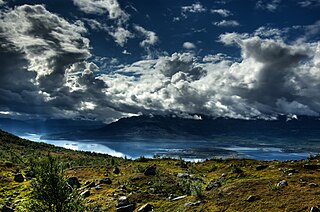
Norrbotten County is the northernmost county or län of Sweden. It is also the largest county by land area, almost a quarter of Sweden's total area. It shares borders with Västerbotten County to the southwest, the Gulf of Bothnia to the southeast, the counties of Nordland and Troms og Finnmark in Norway to the northwest, and Lapland Province in Finland to the northeast.

Haparanda Municipality, is a municipality in Norrbotten County in northern Sweden. Its seat is located in Haparanda.

Norrbotten, known in English as North Bothnia, is a Swedish province (landskap) in northernmost Sweden. It borders south to Västerbotten, west to Swedish Lapland, and east to Finland.
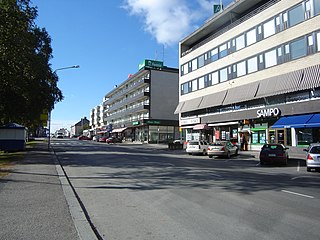
Tornio is a city and municipality in Lapland, Finland. The city forms a cross-border twin city together with Haparanda on the Swedish side. The municipality covers an area of 1,348.83 square kilometres (520.79 sq mi), of which 161.59 km2 (62.39 sq mi) is water. The population density is 17.73 inhabitants per square kilometre (45.9/sq mi), with a total population of 21,048.

Meänkieli is a group of distinct Finnish dialects or a Finnic language spoken in the northernmost part of Sweden along the valley of the Torne River. Its status as an independent language is disputed, but in Sweden it is recognized as one of the country's five minority languages.
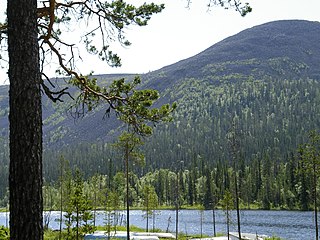
Kolari is a municipality of Finland at the Swedish border, which follows the Torne River, the longest free-flowing river in Europe.

The Torne, also known as the Tornio, is a river in northern Sweden and Finland. For approximately half of its length, it defines the border between these two countries. In the upper parts, the river is situated in Sweden before it meets the Muonio River where it adjoins the international border. It rises at the lake Torneträsk near the border with Norway and flows generally southeast for a distance of 522 kilometres (324 mi) into the Gulf of Bothnia. It is the largest river in Norrbotten County both by length and by watershed area.
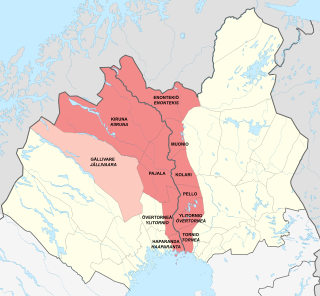
Meänmaa, or sometimes Torne Valley or Torne River Valley lies at the border of Sweden and Finland. It is named after the Torne River flowing through the valley and into the Gulf of Bothnia. Geographically the townships and municipalities that make up the area are Haparanda, Övertorneå, Pajala and Kiruna in Sweden, and Tornio, Ylitornio, Pello, Kolari, Muonio and Enontekiö in Finland. Culturally the highland Swedish municipality Gällivare is sometimes also considered part of Meänmaa due to the large share of Meänkieli-speaking population in it. Torne Valley should not be confused with Torne Valley Sub-region.

The Tornedalians are descendants of Finns who, at some point, settled to the areas of today's Northern Sweden near the Torne Valley district and west from there.

Övertorneå is a locality and the seat of Övertorneå Municipality in Norrbotten County, Sweden with 1,917 inhabitants in 2010.

Torneträsk or Torne träsk is a lake in Kiruna Municipality, Lapland, Norrbotten County in Sweden, in the Scandinavian Mountains. Träsk is the local word for lake. It is the sixth-largest lake in Sweden, with a total area of 330 square kilometres and a length of 70 kilometres. The lake drains to the south-east through Torne river. South-west of the lake lies the Abisko National Park and the UNESCO World Heritage Site Laponian area.

Aavasaksa is a sharp-edged hill in Ylitornio municipality in Finnish Lapland. It has an elevation of 242 metres (794 ft). Aavasaksa is famous for its sights both towards Finland and Sweden, and it is included in the list of the National landscapes of Finland. Decorative hunting cabin "Imperial Lodge" (Keisarinmaja) is one of the buildings on top of the hill. Its construction began with a visit by Alexander II of Russia in mind, but due to political instability it never happened. It's only open in the summer.
Kymmenegård County was a county of Sweden 1775-1809 and province of Grand Duchy of Finland 1809-1831.

The Peräpohjola dialects are forms of Finnish spoken in Lapland in Finland, Sweden, and Norway. The dialect group belongs to the Western Finnish dialects and it is divided into five more specific dialect groups.
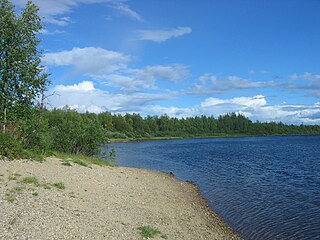
Könkämäeno is a river in Finland and Sweden in Finnish and Swedish Lapland. It forms the upper course of the Muonionjoki river, which begins where the Könkämäeno river meets the Lätäseno river. The river begins from Lake Kilpisjärvi and forms together with Muonionjoki and the lower course of Torne River the border between Sweden and Finland.

The River Torne is a river in the north of England, which flows through the counties of South Yorkshire and North Lincolnshire. It rises at the Upper Lake at Sandbeck Hall, in Maltby in South Yorkshire, and empties into the River Trent at Keadby pumping station. Much of the channel is engineered, as it plays a significant role in the drainage of Hatfield Chase, which it crosses.
Karunki is a locality situated in Tornio Municipality, Lapland, Finland with 483 inhabitants in 2012.
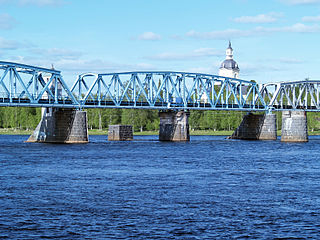
The Torne River Railway Bridge is a dual gauge railway bridge between Haparanda, Sweden and Tornio, Finland; the bridge can be used by the 1524mm gauge trains of Finland, as well the 1435mm gauge trains used in Sweden. A temporary ice river track was built over the Torne River in 1917.
Historisk Tidskrift för Finland is a Swedish-language Finnish history journal which has been published by the Historiska föreningen since 1916. It was founded in 1916 by Per Olof von Törne, who had founded the Svenska studenters historiska förening two years earlier. He served as the journal's editor until 1924. With support for translation from the Delegation for the Promotion of Swedish Literature, managed by the Society of Swedish Literature in Finland, the journal is now also a forum for Finnish-speaking historians. The journal is published four times a year and has approximately 550 subscribers, primarily from Finland, the Nordic countries, and the Baltic region. Each paper is reviewed by two external referees.















